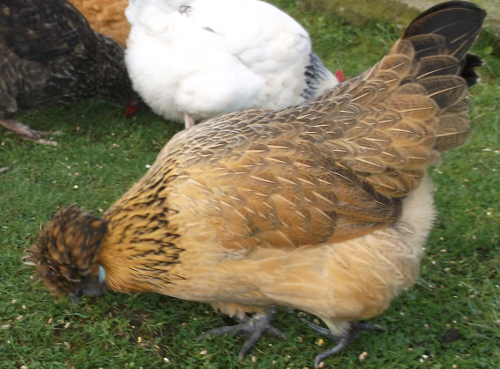Meet the Hybrids
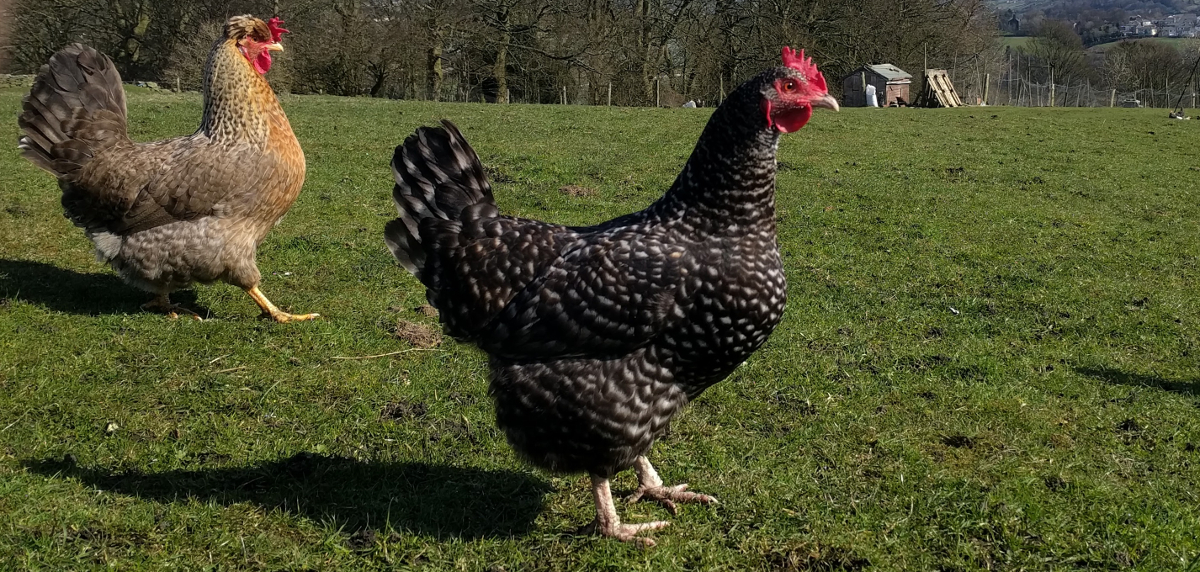
What is a hybrid chicken?
Hybrid chickens are a cross bred mixture of two or more pure breeds, most commonly Rhode Island, Sussex and Leghorns. These cross breeds have hybrid vigour and resistance to disease as well as being very good egg layers. Because of the way they are raised hybrids are docile and have very good food to egg conversion ratios.
Hybrid? Or crossbreed? What's the difference ?
I have kept most of the commercially available hybrids in the last 15 years including quite a selection of ex-battery hens.
A hybrid is a complex bird made up from 3 or more commonly 4 different other breeds of chicken. They might well be the product of several generations of crossing.
A crossbreed would just have the 2 purebred parents whereas a hybrid has crossbred parents. For our purposes the word hybrid will be used for any bird that is not purebred.
The characteristics of hybrids:
- They are fast maturing mid sized birds that lay larger eggs with one or two exceptions.
- Sexable at hatching so you are sure of getting hens.
- Hybrid Chickens convert feed to eggs well and lay between 240 and 320 eggs a year.
- Hybrids are vaccinated,
- Easy to look after and tame.
- Tend to be short lived.
- Diet is important and feed and water need to be always on tap to sustain high production rates.
- Egg quality can deteriorate easily because of the shear number of eggs these hens lay.
Above: Standard brown commercial hybrids like these have become the standard in the eggs industry.
Also known as Hylines, Lohmann browns or Production Red chickens depending on where you are in the world. These birds are crosses of Rhode island Reds and Whites with characteristics selected for over many generations and come in various shades of brown.
Production: Up to 360 eggs per year under commercial conditions but around 300 in standard backyard conditions.
The general idea of hybridisation is to produce offspring with ‘Hybrid Vigour’ . The offspring is better than either of its parents, or inherits certain desirable characteristics, a gestalt entity which is greater than the sum of its parts.
Over the decades millions have been invested in their development; producing hens that require the least amount of input (feed and maintenance), whilst producing the most amount eggs or meat when compared with traditional or heritage chicken breeds.
There is no way the traditional breeds can compete with these types in terms of performance. Heritage breeds still have their advantages. People who keep traditional meat varieties prefer flavour and traditional methods over speed.
Hybrid chickens don't breed true so the companies or breeders keep a closed flock of parent birds. This ensures the quality of the offspring remains the same and they origin stock doesn't become contaminated from the outside.
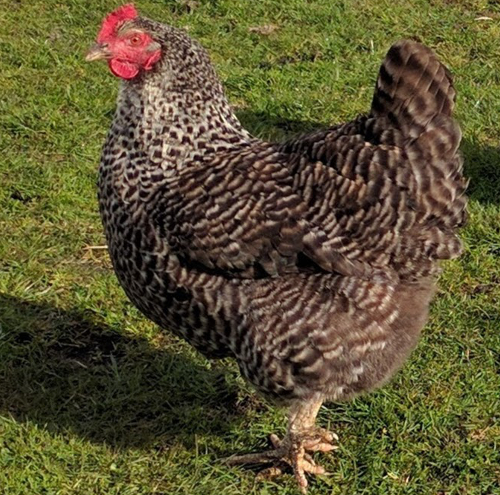
The Speckledy (above) is a cross of Rhode Island Red and Marans and is one of the larger types . Currently have seven of these and they consistently lay 250 brown speckled eggs every year.
Some tips for keeping your Hybrid happy:
- Ample food and fresh water - Super-productive hens need a quality food on tap.
- A routine - Hens and keepers benefit from routine.
- Access to pasture - You will get better eggs from free range hens.
- Hang a cabbage or peck toys in their run to keep them amused.
- They will need somewhere to scratch - and prefer soft dry earth.
- Dust bath - filled with sand and diatomaceous earth where they can wallow.
- Nest boxes and perches - For laying eggs in and resting or sleeping on.
- Calcium or shell added to the feed is a must for layers. hybrids tend to be slight with little in reserve.
A Goldtop or Silkie X Light Sussex is a prime example of a crossbreed. They are used extensively in backyard poultry keeping as broodies. This is one of mine.
It has become common to call any bird bred for a specific purpose a hybrid so for the duration of this article I will call any chicken that is not a purebred a hybrid.
The crossbred Chicken is created by crossing 2 different pure breeds and a hybrid by further crossing or breeding after this stage.
More recently, breeders have been producing hybrids that have attractive egg colours with supermarkets now selling coloured eggs such as those from the Cotswold Legbar or Burford Brown. You can now get rare breed egg colours in easy to hybrid hens.
Some are for laying, while others developed for the table. The latter are usually referred to as broilers.
The US market tends to use leghorn based hybrids as they prefer white eggs. Here in the UK they are sold as White stars. a medium sized bird based on leghorns that lay around 300 white eggs a year. This is one of mine looking for something interesting in the long grass.
It is important to remember they were developed for intensive battery and broiler conditions.
More recently hybrids have appeared for free-range conditions. They are produced for the backyard poultry keeper and smallholder and are a little heavier at point-of-lay. Birds like this tend to be better equipped to cope with outside conditions and cold weather.
Examples include Black Rock, Lohmann Brown, Speckledy, Rangers or Columbian Blacktails. These modern birds tend to lay brown or speckled eggs.
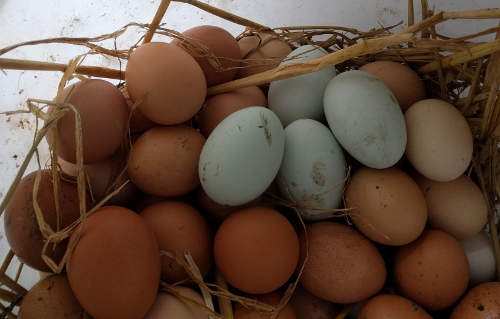
Above: This is a selection of eggs from my hybrids from blue, green to brown.
Specific strains crossed for many generations and creating closed flocks for bio-security, selecting for certain characteristics within the offspring such as egg size or numbers, feed conversion or a broad breast, fast maturity and body weight in the case of table hybrids.
For hobby or backyard poultry keepers there are newer hybrid varieties to choose from that are productive and ideal for beginners.
What are the benefits of Hybrid Chickens?
Hybrid vigour - The parent birds are usually crosses themselves and offspring are usually fit and healthy.
Vaccination - They are vaccinated on or before hatching.
Price - Production costs are low and birds are cheap.
Availability - Produced in large quantities and readily available from more stores.
Cost effective – They are bred with profit in mind and have a good conversion ratio. I.e. More eggs from less feed than say a pure bred bird.
With certain crosses, and always with commercial production, the results are sex linked. This allows the males to identified at day old. This reduces the rearing costs to the breeder and the price you pay for the bird. There is a moral issue surrounding the gassing and disposal of the day old male chicks.
Below: The black rock is a common modern hybrid found in many gardens and egg production businesses.
The black rock is a trademarked name in the UK. It is produced from a Rhode Island Red cockerel and a Barred Plymouth rock hen. The original is produced by the Muirfield Hatchery from specially selected parent stock. You can produce your own but cannot sell them as black rocks. 280 brown eggs per year.
Are there disadvantages to keeping hybrid chickens?
- They are single purpose, laying or broiler.
- Hybrids do not breed true so when you need more of them, you have to go back to crossing the original stock again.
- They can moult very fast and may need shelter and support.
- They tend to lay themselves out inside 3 years and rarely live long.
- The eggs tend to be larger, thinner shelled and more watery than heritage or rare breeds. The egg quality can deteriorate in older birds. This is why they tend to be kept on 80 week laying cycles in the commercial environment. Sheds are stocked and the hens lay for 80 weeks and are then sent for slaughter.
- The diet is important in birds that produce large quantities of eggs. Because of their hyperactive laying habits and lifestyle they need food concentrates on supply at all times. Birds can be bad tempered with each other and their environment may suffer as they scratch through it maniacally.

Above: The blue belle is an attractive modern hybrid bred for the backyard chicken keeper.
Weight: It varies. The layers are usually light and surprisingly feathery, fast maturing with good feed conversion and a POL (point of Lay) around 16/17 weeks. Table hybrids are heavy to provide a predictable sized carcass in a short time so are fast to mature. It is not uncommon for meat types to reach 8Kg at 90 days+. Commercially the time to slaughter is 37 to 62 days depending on the sex of the bird and it’s final use.
Uses: Either eggs or meat but not both. I have found them to be placid and good natured if well fed and make good pets just like most chickens.
Origin: Crosses between pure breeds or other hybrids starting in the early 1930's and took off in the early 1950’s. Borne out of the need to feed ever growing populations and to help cover the food shortages hanging over from the war.
Eggs: Hybrid layers: usually more than pure breeds, in some cases under ideal commercial conditions they can lay an egg a day. Predictable numbers of similar sized eggs of good quality.
Useful to Know: Cheaper than pure breeds, available in quantity and for delivery. Tame. Vaccinated.
Below: Some hybrids are quite light in colour like this ex battery hen.
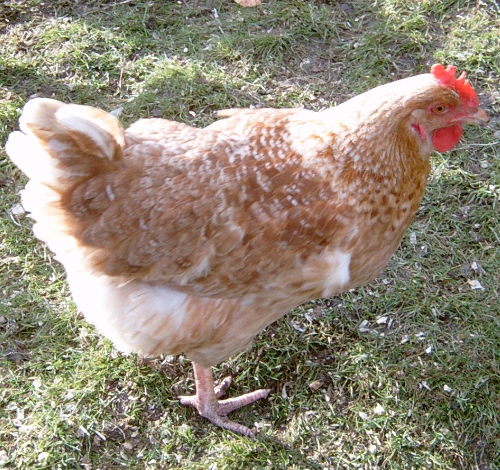
These are birds developed for production by selecting from the best strains. A strain is a family line which has a particularly desirable feature.
Most modern egg laying hybrids, based on the Rhode Island Red or Rhode Island white have other types crossed in. Breeders have spent much effort selecting for various characteristics. White egg layers begin with the White Leghorn like the white star or Sussex star.
These are often the same or similar birds with different names for trademark purposes.
Hybrid breeding hints :
Hybrids do not breed true and there is always some variability. If you cross a hybrid chicken with another breed or cross, you will not get the same bird with the same performance as the original hybrid.
‘Like breeds like’ however and if you are careful with your choice of cross, you can still get some good performing birds.
You can always produce you own, we sold a Barnevelder cross Rhode Island Red or light Sussex. They are auto-sexing at hatch and made a sturdy and hardy layer for the wild conditions here in Yorkshire.
You can still find traditional or heritage chickens that are good layers and reasonable meat producers. One area where traditional varieties excel is uniqueness. You can find all manner of colours and personalities and breeds that fare better in harsh environments.
Also, in my experience, traditional and heritage breeds tend to live longer than the free range hybrid hens I’ve kept.
Are Hybrid hens for beginners?
Very much so. Hybrids are ideal beginners birds, they are usually vaccinated and are generally quite tame and easy to handle and do not take quickly to the wing.
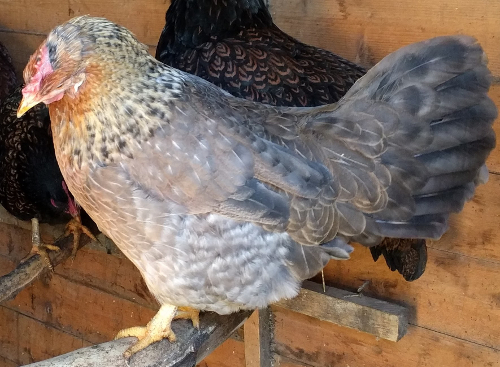
The Columbine is green / blue egg hybrid – based mostly on the cream crested Legbar known by a great many names depending on where you are in the world. This bird has around an 85% chance of laying a green / blue egg and they can look very different.
How much to pay for hybrids?
American ($) and English (£) prices are broadly the same. By this I mean the same amount of dollars and pounds will buy you roughly the same amount of chickens.
They are cheaper than pure breeds, you can expect to pay between £10 and £15 for a POL (Point of Lay) Hybrid. I have bought them POL as cheap as £5.50 a bird, depending on how many you buy. Compared to £25 – £35 for a pure breed hen.
Chicks start from £0.90 for 500 up to £2.95 each for 12 . Again it depends on how many you buy.
A selection of popular hybrid laying hens:
So what is the best egg laying chicken? This is a common questions asked most poultry keepers at one time or another.
This is a list of the common hybrids available.
This was my best layer ever. She was an amber star called cappuccino and she produced 353 eggs in her 1st year. She did however die age 2 ½ after laying around 600 eggs.
Below: The amber star.

Amber Stars, or Amberlinks, are another Rhode Island based hybrid. Mine have been happy and friendly as well as being escape artists and flying surprisingly well for a chicken.
These birds will be prolific layers under the right conditions. After twelve months egg production tends to tail off a bit – some types are worse than others. However, they do tend to start laying bigger eggs after the first year.
The Utility Sussex is a Rhode island cross light Sussex and the hens grow up to look like a very pale light Sussex. They lay around 280 pale cream eggs in their first year.
Below: the utility Sussex, sometimes known as the Sussex ranger.

Goldline – The Goldline or Bovans Goldline is the name of a commercial strain of hybrid hen produced by Joyce & Hill Poultry Ltd. This is a common bird in the United Kingdom and is the result of many years of breeding and crossing.
Below: The Goldline / Lohmann brown. These plain brown birds are more commonly known by numbers.

This is a very plain average size brown hen that lays large pinkish / cream shelled eggs. It is not common in the US or anywhere the white egg is preferred. They are colour sexed at day old.
Below: The Black Tail or Gingernut Ranger. I used to call these Calder Valley rangers when I sold them.
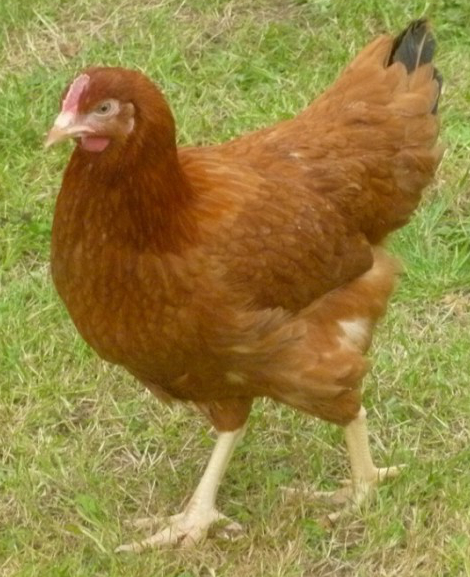
To sum up : There are a great many varieties of hybrid chicken. Whichever you choose is going to be a matter of personal choice as they are all broadly similar.
For olive eggers - see here. and for Cinnamon Queens see here.


